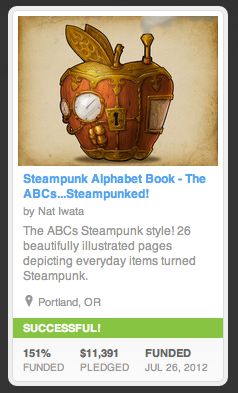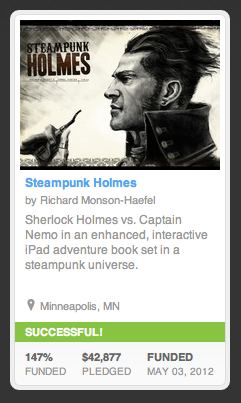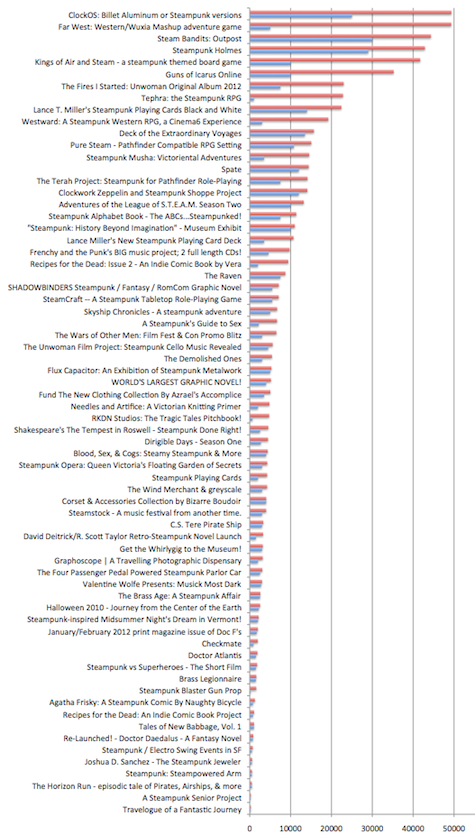Are you considering launching a Kickstarter project? As a marketer specializing in publishing and technology projects, I get numerous requests from startups to market their Kickstarter campaigns. Currently, I’m researching steampunk projects on Kickstarter in preparation for the upcoming Steam Patriots campaign for Noble Beast and I thought I’d share some tips with you.
In the spring of 2012, I marketed the Steampunk Holmes Kickstarter campaign which surpassed its $29,000 goal to be funded for a total of $42,877. In that campaign we learned as much about what not to do as we learned about what to do.
It’s becoming more difficult to get noticed on Kickstarter just as it has become difficult to get noticed on iTunes or Amazon. The crowdfunding field is getting, well, crowded. It’s going to get much worse, so if you think you might want to jump in the crowdfunding pool, now is the time to do so.
I took some time last week to carefully analyze the 133 self-described steampunk projects posted on Kickstarter. I found a few traits that make some of them more successful than others. I use steampunk projects as examples, but these traits could apply to any category or genre. Note that 54% of the steampunk projects were successfully funded, so you have a fighting chance to get your dream steampunk project funded.
Below are10 tipsto help you succeed with your own Kickstarter campaign based on this specific research:
1. Build up a social media presence in advance
Invite your personal network to contribute to your crowdfunding campaign, but don’t count on your friends and family to carry your Kickstarter project. Face it, those 300 friends on your Facebook page are mostly from high school and they may have no interest in your project.
Set up dedicated social media accounts for your particular project well in advance of your launch. Follow people who are most likely to be interested in your project.
Make sure you have an account on Twitter and Facebook at the very least, and consider Google+, Tumblr, Pinterest, etc.Remember to include your social media links and contacts on your Kickstarter page.
2. Read about other successful Kickstarter projects
Find projects similar to yours and read everything about them. Watch the videos and decide for yourself what works and what doesn’t work.
opens in a new window 3. Collaborate with partners
3. Collaborate with partners
You may have to think creatively to come up with another company, creator, or partner who is interested in working with you. The idea is that you both can use your networks to talk about each other and get the word out about the project and the partner’s work. For example, in the steampunk world, you can contact your favorite steampunk artisans, musicians and writers to ask them if they want to be involved with your project. Cross-marketing is fun and it builds a supportive, helpful community around shared interests.
4. Create a project that people find interesting
Yes, this is easier said than done. It helps if you go outside yourself a bit. Do you want to Kickstart a photo album of your kids? Only grandma is going to back such a project. Make sure the appeal is wide enough to include more than your immediate family. Ask yourself: is my project useful, helpful or at least interesting in some way? Does it make the world a better place? Is it a work of art? Is it new, novel, unique in any way? It doesn’t have to be all of the above, but try to answer yes to at least one of these questions.
5. Make a good video
A good Kickstarter video should show your passion for the project, your commitment, and your expertise in the field. Feel free to make it fun or funny, as long as the people watching it know that you are going to be serious about following through with the project.
6. Offer quality and value in the rewards
Offering an ebook at the $100 reward level does not inspire support. Include exclusive rewards at reasonable levels – both for the 99% and the 1%. Feel free to throw in one high-priced level with multiple exclusive rewards. You may be surprised at how eager some of your fans will be to have that extra perk or access. Accurately budget the cost of the rewards, including shipping costs and your time for processing.
opens in a new window 7. Explain rewards and levels carefully
7. Explain rewards and levels carefully
Aside from providing access to the final product, think creatively about what kind of extra perks you can include in the rewards.
Kickstarter rewards are difficult to format for readability. I’ve often started to back a project and then given up due to the complexity of the reward system. In addition to the rewards outlined on your Kickstarter page, consider putting a rewards chart on your website or in the body copy of your Kickstarter project page.
8. Plan stretch rewards in advance
What if you reach your goal early? Plan some further phases of your project that you can post with new rewards in case your goal is reached in advance.
9. Make it authentic
Don’t just throw some gears on a project and call it steampunk. Although it does help your project to have some timely application, gimmicks do not a successful project make.
10. Check it out
Before you launch your project: spell check and proofread your project. Let someone else review it before you click to submit.
List of Successful Steampunk Projects on Kickstarter:
Pledged vs. Goal as of mid-September 2012. Click the chart to see full-size.
Note: Some of the projects listed above had not yet ended when this chart was created.
The Numbers
Total: 126 Kickstarter steampunk projects (not including currently active projects)
- 58 unsuccessful (15 without videos/53 with videos)
- 68 successfully funded (19 without videos/49 with videos)
- 14,625 backers total
- 215 average backers per project
- $9,728 is average total pledged to project
- $660,649 is total pledged to successful projects
- 248% is average percent of goal funded
- $5017 is average funding goal
Disclaimer:
As of mid-September some of the projects on our list have not yet ended but have been included in our research since they have met their funding goal.
If you have any updates to the above data, feel free to post corrections in the comments below.
Julie Brannon is a writer and marketing consultant. She has previously worked with publishers and developers including One Hundred Robots, Adventure House Communications Group, the George Project, and Noble Beast . She writes for the Social Media Monthly magazine. Twitter @Julia_Brannon












